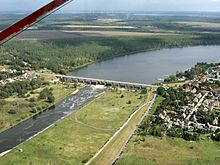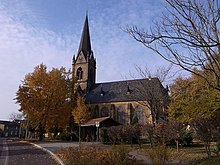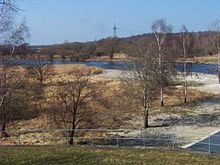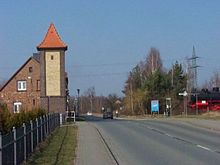Friedersdorf (Mulde)
|
Friedersdorf
Community Muldestausee
|
|
|---|---|
| Coordinates: 51 ° 38 ′ 51 ″ N , 12 ° 22 ′ 2 ″ E | |
| Height : | 86 m above sea level NN |
| Area : | 4.38 km² |
| Residents : | 1971 (Dec. 31, 2007) |
| Population density : | 450 inhabitants / km² |
| Incorporation : | January 1, 2010 |
| Postal code : | 06774 |
| Area code : | 03493 |
Location of Friedersdorf in Saxony-Anhalt |
Friedersdorf is a district of the municipality Muldestausee in the district of Anhalt-Bitterfeld in Saxony-Anhalt , Germany.
The Friedersdorf district has an area of 439 ha and has about 1970 inhabitants. Since 1997, Friedersdorf has been the first German book village with the neighboring town of Mühlbeck .
In the 3rd state competition 1996/1998 "Our village should become more beautiful - our village has a future", the Friedersdorf community achieved 2nd place.
geography
Friedersdorf lies between Bitterfeld and Lutherstadt Wittenberg . The district borders in the north on the Muldestausee and in the south on the Bernsteinsee, which is part of the Goitzsche . The Dübener Heide nature park begins at the inlet to the Mulde reservoir .
The place (83 m above sea level) is on the B 100 , about five kilometers east of Bitterfeld . The next largest cities are Leipzig (40 km) in the south and Halle (Saale) (35 km) in the south-west.
history
On June 6, 1222, Friedersdorf was first mentioned as Fridrichestorf . The place was founded (according to a publication by the community on the Internet in 2009) in the 12th century under the rule of Count von Brehna - probably by Count Friedrich I (1156–1182). The Low German evidence for the place name suggests settlement by residents from areas west of the Saale and north of the Unstrut . The Urfriedersdorfer may also have come from there. Count Friedrich II probably gave the place to the diocese of Meißen in 1217. In the deed of gift dated June 6, 1222, the place is called "Friedrichestorf", which is also the likely origin of the name.
In 1581, the Electors of Saxony took over Friedersdorf's territory as a property after having previously held it as a fief . In the Meißner diocese article the place was called "Freddersdorff". The place belonged to the Electoral Saxon Office Bitterfeld until 1815 . The brothers Hermann, Heimrich and Nicol von Sittewitz (Zitzewitz) took over the place Friedersdorf in 1448 from Hans and Bernhard von Ochelitz. In 1454 the Mulde moved its bed, the Cirius werder was created. The land belonging to Mühlbeck was cut through and the Great Flemingswerder was built in front of Friedersdorf .
Friedersdorf was independent until 1464. In 1471 Kurt von Ammendorf was named the owner of the Fridisdorff farm . After that the property belonged to Alt-Pouch. After a devastation in 1637, the village was rebuilt along the old course of the Mulde. Kurt von Ammendorf founded the Franciscan monastery in Stanislaussigk (Muldenstein) in 1476 , but it was dissolved again by the Reformation in 1531. In 1517 the reformer Dr. Spot the prior. Around 1547 the church in Friedersdorf was also looted by Spanish soldiers who had come to Bitterfeld with Charles V to celebrate Corpus Christi. Altar and bell were spared, while the bell was stolen in Mühlbeck .
There is evidence that there was a brick kiln in Friedersdorf around 1500. The clay was taken from the brick corridor of the floodplain. The Friedersdorf Altar is said to have been completed in 1520. At that time Friedersdorf was a branch church of Kamnitz (Burgkemnitz); the pastor's seat was Kemnitz.
Heinrich von Gleißenthal burned around 75,000 bricks in three ovens in Friedersdorf in 1558 and erected new buildings in Gut Muldenstein. Since that time the old Steinlaussigk Mildenstein Gut Muldenstein has been called. In 1575 the name Friedersdorf appears for the first time in the church visit protocols in its current spelling. On February 13, 1637 Friedersdorf was sacked by Sweden. 80 percent of the population were slain; 70 percent of the buildings were destroyed.
Friedersdorf remained in the area of the Electorate of Saxony until 1815, and since 1806 with the Kingdom of Saxony . The decisions of the Congress of Vienna he came to Prussia and in 1816 the district Bitterfeld in the administrative district of Merseburg of the Province of Saxony assigned to which he belonged until 1944th
The part now known as the Old Cemetery was first laid out in 1832. Between 1856 and 1859, around 300,000 cubic meters of stone were quarried from the porphyry quarries and used to build the railway lines. In 1862 the Friedersdorfer clays began to be increasingly used for clay tube production in Bitterfeld.
The Friedersdorf gymnastics club was founded in 1888 and Hühniches Mühle was built in 1889. In the same year the Friedersdorfer Ziegelwerke were founded (in 1967 they were closed and dismantled after an eventful history). Construction of the new church began in 1897 and the church was consecrated on July 20, 1899. In 1899 the construction of the new school began (third expansion stage was 1930). In 1900 the old Friedersdorf church was sold and demolished. In 1906 the main street through Friedersdorf was paved.
In the 19th century Friedersdorf was mainly the residence of many working class families who were active in the surrounding industry (Reichsbahnkraftwerk, mining). The Muldestausee was created through the work of the opencast mine. With the flooding of the former Goitzsche opencast mine, to which part of the Friedersdorfer Aue was sacrificed, the Great Goitzsche Lake was created.
In 1909 the Muldenstein railway power station was founded. Above all, it produced electricity for the electrification of the railway, making it the most important employer for Friedersdorf families. The plant was dismantled in 1946, but rebuilt from 1952 to 1956, and in 1994 it was finally shut down.
SV Friedersdorf was founded in 1920 as a football club .
In 1930 a post office was reopened in Friedersdorf (one had already existed from 1900 to 1924). It lasted until 1996 and then became a point of sale in a supermarket.
The first allotment gardens were founded in 1932. In 1933 the first mandolin orchestra was founded. It existed until 1975. When the village was beautified in 1934, linden trees were planted. The Fichtenbergsiedlung was built from 1936 to 1940. In 1939 the Friedersdorfer Flur covered an area of 6.35 square kilometers. In 1940 the light plays in Friedersdorf were opened. In 1969 they were closed again and converted into a gym. Today (2010) the building is used as a garage.
In 1941 six high-explosive bombs fell in the Friedersdorfer Muldesee. In 1945 Friedersdorf was conquered. On April 24th, citizens of Friedersdorf handed the place over to the 1st US Army. After Germany's unconditional surrender, the Americans shot salutes in Bitterfeld. On May 2, the Red Army occupied the place. The Russian bridge over the Mulde was completed on June 21, 1945. The Heroes' Cemetery was laid out on June 27; 54 unknown concentration camp prisoners and 14 killed Germans rest here.
The 1946 census found that 5.8 percent of Friedersdorfer are employed in forestry and agriculture , 52.3 percent as workers. School meals were introduced in 1950. In 1951, work began on the development of the Muldenstein opencast mine . In 1956, the construction of the third Friedersdorf cemetery began. In 1958 the LPG "New Life" was founded. It consisted of four farms with about 350 hectares.
In 1975 the Mulden reservoir was flooded and the Mulde was relocated through the remaining hole in the Muldenstein open-cast mine . The Friedersdorfer Aue lost its floodplain character. In 1990, parts of the Mulde reservoir were declared a nature reserve. In 1992 the village center was completely renovated. In 1993 the sports hall was completed. In 1997 the 775th anniversary took place. During the great flood of 2002, the Mulde broke through the dams in Saxony and led the water into the Goitzsche opencast mine. This means that the controversial filling of the remaining hole area was completed in one day, which should take years from the planning. Around 2005, the Friedersdorf writer Peter Hoffmann began collecting anecdotes from village life . The collection of these events from Friedersdorf later found space in several public readings and books published by Peter Hoffmann in two publishers. (See literature list.)
Since January 1, 2010, the formerly independent community Friedersdorf has been part of the Muldestausee community. Until July 1, 2007 it belonged to the administrative community Bitterfeld-Wolfen .
politics
mayor
The last mayor of the independent community Friedersdorf was Karsten Döring (CDU).
badges and flags
The coat of arms was approved by the Dessau Regional Council on March 27, 1997 and registered in the Magdeburg State Archives under the coat of arms roll number 19/1997.
Blazon : "In green a golden linden tree on a silver corrugated shield base, in it three red sea leaves in bars, the middle sea leaf slightly larger."
The colors of Friedersdorf are gold (yellow) - green.
The golden linden tree in a green field symbolizes the typical tree population of the place. The linden tree is one of the oldest and most evocative figures in heraldry. As a cult and judgment symbol of the Germanic peoples, it is the people's favorite tree. The idea of nature is associated with the green field. The silver corrugated shield base characterizes the location of the community on the Muldestausee. The three red sea leaves refer to the coat of arms of the Counts of Brehna. They are in the coat of arms, as it is very likely that Friedersdorf got its name after a Count von Brehna. The time of the establishment of the place should be put in the reign of Count Friedrich I. According to a document, Friedersdorf is first mentioned in the spelling Friedrichestorf on June 6, 1222.
The coat of arms was designed by the heraldist Frank Jung .
The flag is green - gold - green striped lengthways. The coat of arms is placed in the middle of the wider median of the flag.
partnership
A partnership with the municipality of Zell unter Aichelberg from Baden-Württemberg has existed since 1997 .
Attractions
- Evangelical church with winged altar from the 16th century, baptismal angel and organ from the Rühlmann workshop
- Technical monument steam storage locomotive
- Steinberg natural monument (porphyry dome) with elevated drinking water tank
- Mulde reservoir
Economy and Infrastructure
economy
The closure of brown coal mines in the region, through the open pit also strongly shaped the landscape, difficult economic situation of the population. With the idea of a book village , which was initiated in 1997 together with the neighboring town of Mühlbeck , new employment opportunities were to be created and tourists were to be attracted to the area. In the meantime, antiquarian books are offered in 15 shops.
traffic
The federal highways 100 and 183 from Bitterfeld-Wolfen to Wittenberg run directly through the town .
Personalities
- Ernst Lausch (* 1836; † 1888): Born in Friedersdorf, the pedagogue, writer for children and young people, was also the editor of the school paper of the province of Saxony for many years . His fairy tales, stories, songs, rhymes and riddles appeared in numerous editions.
- Dietrich Freydank (* 1928; † 1999), Slavist, university professor
- Peter Hoffmann (* 1956 in Friedersdorf); first railroad worker, later studies at the Leipzig Institute for Literature; then editor, publicist of many regional works and writer ( color mix, 1996; the swallow may come again, 1998; when Bitterfeld had another beer, 2000; Wendelin stories, 2001; people from Friedersdorf, volumes I - IV (see references)), Publication of anthologies, e.g. B. Vanishing point (2005) and summer sunset (2006) with contributions from young people in the region.
literature
- Lothar Herbst: Friedersdorf Stories, Friedersdorf Community 1997
- Friedersdorf in the past and present, ed. Friedersdorf community 2002
- Peter Hoffmann : Life in Friedersdorf, Volume 1. Engelsdorfer Verlag, Leipzig 2007; ISBN 978-3-86703-537-8
- Peter Hoffmann: Leben in Friedersdorf, Volume 2, Edition Winterwork, Grimma 2008, ISBN 978-3-940167-33-0
- Peter Hoffmann: Leben in Friedersdorf, Volume 3, Edition Winterwork, Grimma 2009, ISBN 978-3-940167-89-7 .
- Life in Friedersdorf. Part 4, Borsdorf 2010, ISBN 978-3-942693-23-3 .
- Life in Friedersdorf. Part 5, Borsdorf 2014, ISBN 978-3-86468-835-5 .
Web links
Individual evidence
- ^ Karlheinz Blaschke , Uwe Ulrich Jäschke : Kursächsischer Ämteratlas. Leipzig 2009, ISBN 978-3-937386-14-0 ; P. 22 f.
- ^ The district of Bitterfeld in the municipality register 1900
- ↑ StBA: Area changes from January 01 to December 31, 2010









